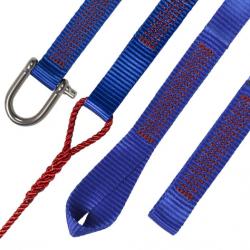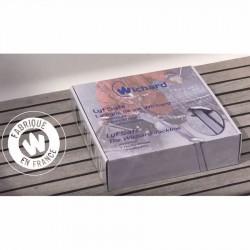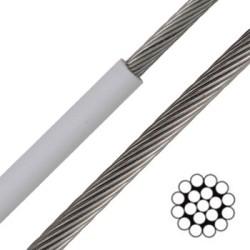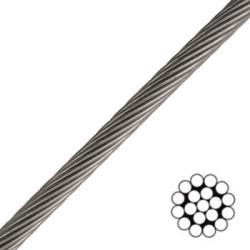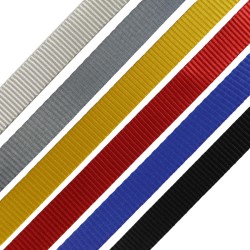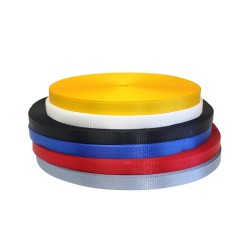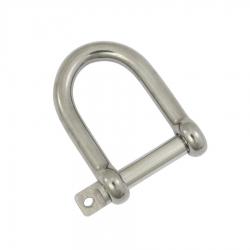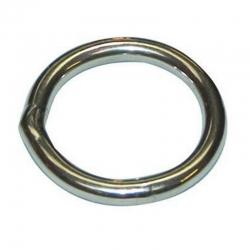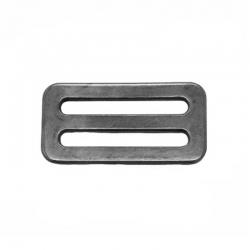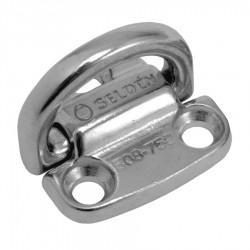What are Jackstays?
Jackstays, also sometimes confusingly referred to as Lifelines or Jacklines, lay along the deck ready for you to clip to with your harness safety line. Your safety line may also be referred to as a safety tether or again, confusingly, as a lifeline.
The Jimmy Green Rigging Team are well versed in creating Custom Made Jackstays, made to measure in webbing, Dyneema fibre rope or stainless steel wire:
Webbing Jackstays are produced to order, in house, by the Jimmy Green Sewing Team, on a state of the art, automatic profile, heavy duty industrial Ultra-Sew machine using a tested and proven stitch pattern so you can rely on their strength and durability.
Jimmy Green webbing jackstays are produced in high tenacity, UK manufacture, 100% polyester webbing.
- MBL 2000kg, available in Blue, Red, Yellow and Black
- MBL 3000kg, available in White
- The 25mm webbing will fit comfortably onto the pin of our Extra Wide Stainless Steel Shackles.
Dyneema Fibre Jackstay Lines are spliced to length in the Jimmy Green Splicing Centre, the hub of our Custom Rigging Service operation. Dyneema Jackstays are available to order online in 5mm or 6mm diameter in a choice of ropes - LIROS D Pro Static or Hampidjan DynIce Dux.
Stainless Steel Wire Jackstays are prepared to your bespoke measurements and terminated on state of the art Wireteknik Roller swaging machines or for terminations around a thimble, on genuine Cabco Talurit Hydraulic presses in the Jimmy Green Rigging Workshop.
Wire, Fibre and Webbing Strength Comparison:
4mm 1 x 19 stainless steel wire, KOS MBL = 1400kg 5mm 1 x 19 stainless steel wire, KOS MBL = 2000kg 6mm 1 x 19 stainless steel wire, KOS MBL = 2880kg
High Tenacity Polyester Jackstay Webbing, MBL = 2100kg or 3000kg. The majority of jackstays produced are from the 2100kg webbing, but the stronger webbing, MBL 3000kg is very popular.
LIROS Break Load for D Pro Static - 5mm = 2450kg, 6mm = 4050kg Hampidjan Break Load for DynIce Dux - 5mm = 4.8 tonnes, 6mm = 6.8 tonnes
N.B. All wire/rope splicing and sewing marginally reduces the breaking strain of the finished product.
Hampidjan publish a Spliced Break Load i.e. the strength of the line after it has been spliced. DynIce Dux Spliced Break Load - 5mm = 4.3 tonnes, 6mm = 6.1 tonnes
Wire, Fibre and Webbing Stretch Comparison for the purpose of setting up Jackstays and Lifelines:
1x19 stainless steel wire - zero stretch LIROS D Pro Static – Near zero elongation and creep Hampidjan DynIce - Near zero constructional stretch and creep High tenacity polyester webbing – 15% to 20% elongation at rupture suggests an estimated 2.5% stretch at the likely loads associated with a fall - this equates to approximately 8 inches on an 8 metre jackstay.
Wire, Fibre and Webbing UV Resistance Comparison for Jackstays and Lifelines: 1x19 stainless steel wire - Zero deterioration N.B. PVC has good UV resistance but does suffer from sun damage. LIROS D Pro Static – Dyneema has good UV Resistance and is additionally protected by a PU impregnation process - the LIROS Coating System provides extra UV and abrasion resistance. Hampidjan DynIce - Dyneema has good UV Resistance and is additionally protected by a PU Coating - impregnation with Durapur for added protection and improved abrasion resistance. High tenacity polyester webbing has excellent UV and abrasion resistance
Measuring your Jackstays
All deck jackstays should be fitted so that there is a degree of lift in the centre of the line before any significant load is applied.
The height of the lift should be proportional to the overall length of the jackstay and make allowance for the stretch of the jackstay.
Webbing Jackstays should therefore be fitted taut to prevent too much slack when a body weight load is applied.
Wire and Fibre, in contrast will need to have a degree of slack to prevent excessive load on the end fittings when under load, due to a 'bowsing' effect.
It may also be difficult to get the safety tether hook under a tight fibre rope or stainless steel wire.
Jackstay and Lifeline Fitting Considerations
Safe Attachment - It is important to be able to clip on to the jackstay line while you are in the cockpit and still be able to venture as far forward (and aft) as possible without having to detach yourself.
This means that the jackstay line needs to 'overlap' the cockpit domain (it should at least run by the outside of the coaming so you can reach it from inside the cockpit) It also needs to negotiate a path around or over the natural obstacles such as hatches, lower shrouds, grab rails, cleats, windlasses, bollards etc. so that the person clipped on to the jackstay line has a clear path to the forestay/pulpit (or pushpit)
Man Overboard Prevention - the path forward should be as near the centre line as practicable
e.g. inside shrouds, over but commonly around the curve of the coachroof.
Clipping on to a jackstay that is too near the guardrail may result in a casualty left dangling in the water after the fall has beeen arrested e.g. outboard of the leeward rail with the yacht heeled over.
N.B. The MAIB SAFETY BULLETIN 1/2018 has highlighted the importance of routing any jackstay or lifeline in such a way as to minimise the chances of a hook getting caught underneath any deck fitting and especially mooring cleats.
"SAFETY LESSON To prevent the strength of a safety harness tether becoming compromised in service, due to lateral loading on the tether hook, the method used to anchor the end of the tether to the vessel, should be arranged to ensure that the tether hook cannot become entangled with deck fittings or other equipment"
Main Menu
Main Menu
Back
Main Menu
Back
Main Menu
Back
Back
Main Menu
Back
Main Menu
Back
Back
Main Menu
Back
Main Menu
Main Menu
Back
Main Menu
Back
Back
Back
Back
Back
Back
Back
Back













